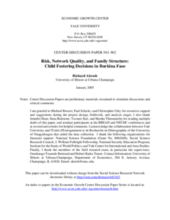Although previous research often assumes that household structure is exogenous, the results of this paper provide strong evidence against the validity of that assumption. This paper analyzes a household’s decision to adjust its composition by sending and receiving children and finds that a household is significantly more likely to send out a child if it experiences a negative income shock, has a better quality social network, or has additional children in a given age and gender class. Quantifying the magnitude of this impact shows that increases of one standard deviation in a household’s agricultural shock, percentage of good members in its network, or number of older girls would increase the probability of sending a child above the current level of fostering by 29.1, 30.0, and 34.5 percent, respectively.
The research methodology that involved locating the sending and receiving households participating in each fostering exchange makes these data well-suited for examining explanations for changes in household structure that previous researchers could not. In particular, this is the first paper to provide empirical evidence that households use child fostering as a risk-coping mechanism in response to adverse shocks and income fluctuations. It is also the first paper to analyze and quantitatively measure the importance of social networks for the child fostering decision. Future research should take advantage of these data to extend this analysis by measuring the impact of social networks on children’s educational and welfare outcomes. In addition, to further understand the endogeneity of household structure, future research should examine the factors influencing the timing of new household formation.
Understanding why households engage in this social institution has significant policy implications for international development organizations who are currently trying to prevent children from growing up away from their biological parents. However, related research using these data indicates foster children are not negatively affected (in terms of school enrollment) in either the short-run or long-run by living away from their biological parents (Akresh, 2004). If child fostering insulates households from adverse shocks, provides them access to the benefits of extended family networks, and moves children to households where they are more productive, then restricting the movement of children as a policy prescription should be reevaluated. The prevalence of child fostering as a means for a household to adjust its structure suggests it is also critical for governments and development organizations, in designing and evaluating policies, to allow for the possibility that a household changes its size in response to programs (Edmonds, Mammen, Miller, 2005).
These results about why a household adjusts its structure also have implications for the larger issue in Africa and even the United States of how to define a household and who should be considered as actors who potentially influence a child’s welfare outcomes. Children living away from their biological parents is not a phenomenon restricted to Africa. Using the 1910 United States census, Moehling (2002) found evidence that 3 percent of white mothers and 12 percent of African-American mothers under age 35 had children not living with them. More recent evidence from the National Longitudinal Survey of Youth, a representative sample of children aged 14 to 21 as of 1979, shows that 2.6 percent of non-orphaned white children and 5.2 percent of non-orphaned black children under age 15 were not living with either biological parent (Haurin, 1992). Whenever household size and composition are choices, researchers need to consider the potential biases arising from endogenous household structure.
©Economic Growth Center (Yale University)

